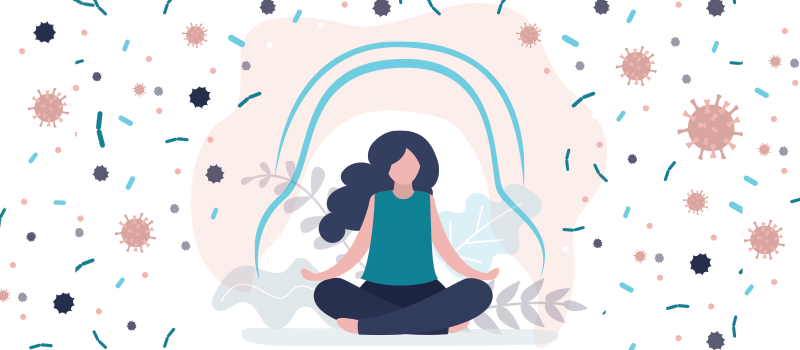What’s the Buzz
The Bee Healthy Blog
20 Signs of Lupus in Women

Key Takeaways
-
Systemic lupus erythematosus is a chronic autoimmune disease that attacks different body systems or parts such as skin, joints, kidneys, lungs, heart, and the central nervous system. Lupus is most commonly found in Hispanic, African American, and Asian American people and women.
-
The biggest indicators of lupus are a butterfly rash on the bridge of the nose and the cheeks, unexplained fever, fatigue, hair loss, sun sensitivity, skin rash, painful and swollen joints, and kidney problems.
-
There is no cure for lupus, but it can be treated with a variety of medications that are decided based on symptoms, severity, and frequency of flare-ups.
There are approximately 200,000 adults living with systemic lupus erythematosus (SLE or “lupus”) in the United States, according to the CDC and Lupus Foundation. Lupus is more common in Hispanics, African Americans, and Asian Americans. Furthermore, lupus affects women more than men. Specifically, lupus is more common in women between the ages of 15 and 44. Please continue reading to learn more about the signs and symptoms of lupus in women.
What causes systemic lupus erythematosus (SLE)?
Systemic lupus erythematosus is a chronic autoimmune disease. Autoimmune diseases occur when the body’s immune system mistakenly attacks healthy tissue. For example, in rheumatoid arthritis (RA), the immune system attacks the joints. In people with lupus, the immune system could affect different body systems or parts such as skin, joints, kidneys, lungs, heart, and the central nervous system. This abnormal activity of the immune system is what causes a person to develop lupus. The exact cause of lupus is still unknown at this time, but it is believed to be due to a combination of environmental factors and genetic factors.
Some types of lupus, such as discoid lupus erythematosus and subacute cutaneous lupus erythematosus, affect only the skin. They are associated with skin symptoms such as skin rash, sensitivity to sun exposure, hair loss, swelling of the blood vessels, and skin ulcers.
Neonatal lupus occurs in newborn babies due to antibodies acquired from the mother. It can cause symptoms such as skin rash, liver problems, and low blood cell counts. These are usually temporary and go away after several months without any lasting damage. These antibodies can come from mothers who have lupus. However, it is also normal for an infant to have neonatal lupus when the mother does not have lupus currently. On the other hand, if the mother has lupus, it does not mean lupus will be passed on to the baby.
Certain medicines can trigger lupus-like symptoms, including joint pain, muscle pain, fever, and other symptoms. This is called drug-induced lupus. It does not usually affect the major organs and goes away once the medicine is stopped.
What does undiagnosed lupus look like?
Early diagnosis of lupus can be challenging because it affects many organs in the body and can mimic other conditions. Some of the early signs of lupus include fatigue, fever, skin rashes, and joint pain. Doctors can make a lupus diagnosis based on the results of many tests, including:
-
Blood tests such as a complete blood count to measure red blood cells, white blood cells, platelets, and hemoglobin
-
Erythrocyte sedimentation rate (ESR) to measure how fast red blood cells settle in a tube (ESR is often raised in people with inflammatory conditions such as lupus)
-
Urine tests to check for kidney problems
-
Kidney function tests to check for kidney damage
-
Liver function tests to check for liver damage
-
Antinuclear antibody (ANA) (the presence of these antibodies in the blood indicates an overactive immune system). Since the ANA test is not specific for lupus, if ANA is positive, it is recommended to test for a more specific antibody
-
Echocardiogram to check heart function
-
Skin biopsy or kidney biopsy
What is the biggest indicator of lupus?
Symptoms vary from person to person. However, one of the biggest indicators in lupus patients is a malar rash (butterfly rash) on the bridge of the nose and the cheeks. This early sign can be accompanied by unexplained fever, fatigue, hair loss, sun sensitivity, skin rash, painful and swollen joints, and kidney problems.
What are usually the first signs of lupus?
Common symptoms and signs of lupus include:
-
Fatigue
-
Fever
-
Swollen and painful joints
-
Skin rashes, including a butterfly rash on the face
-
Sun sensitivity (skin lesions that are worse with sun exposure)
-
Blue/white fingers and toes in cold weather or stressful conditions
-
Hair loss
-
Chest pain
-
Shortness of breath
-
Anemia
-
Blood clots
-
Kidney problems
-
Dry eyes
-
Dizziness
-
Headache
-
Vision changes
-
Confusion
-
Memory problems
-
Behavior changes
-
Effects on mental health, including depression
People with lupus are at an increased risk of more serious complications such as kidney disease, including kidney failure requiring a kidney transplant, seizures, and cardiovascular disease (stroke and heart attack).
What are lupus symptoms in women?
Visible symptoms of lupus in women are similar to those in men. As mentioned, lupus is up to 9 times more common in women than men. Symptoms of lupus can include fatigue, unexplained fever, hair loss, skin rash, joint pain, kidney problems, lung problems, thyroid problems, gastrointestinal symptoms, dry mouth, dry eyes, dizziness, ulcers, chest pain, osteoporosis, and depression. While fertility is not usually affected by SLE, lupus can increase the risk of pregnancy complications such as preeclampsia, causing dangerously high blood pressure during pregnancy.
How do doctors treat lupus?
Systemic lupus erythematosus is a lifelong chronic condition without a cure. However, doctors can treat lupus with a variety of medications depending on the signs and symptoms. Lupus symptoms tend to flare up and subside, and the treatment plan needs to be adjusted as the symptoms change. Some of the medications that may be prescribed to people with lupus include:
-
Nonsteroidal anti-inflammatory drugs (NSAIDs) to treat fever, pain, swelling, and other mild symptoms during lupus flares. These medications are also available in prescription forms for severe pain. Examples include ibuprofen (Advil, Motrin), naproxen sodium (Aleve), meloxicam (Mobic), celecoxib (Celebrex), etodolac (Lodine), and others. Possible side effects of NSAIDs include bleeding in the stomach, kidney problems, and an increased risk of heart problems.
-
Antimalarial drugs to control symptoms and decrease lupus flares through their effects on the immune system. Examples include hydroxychloroquine (Plaquenil). Possible side effects of antimalarials include upset stomach and, rarely, damage to the retina in the eye.
-
Corticosteroids for their anti-inflammatory properties to control severe lupus that is affecting the kidneys and brain. Examples include prednisone and methylprednisolone (Medrol). Topical steroids may be used to treat skin rashes. Side effects of steroids include easy bruising, weight gain, thinning of the bones, high blood sugar, high blood pressure, and an increased risk of infections. Steroid side effects are more likely with higher doses or long-term treatment.
-
Immunosuppressants to suppress the immune system. Examples include mycophenolate (Cellcept), cyclosporine (Neoral, Sandimmune, Gengraf), azathioprine (Imuran, Azasan), methotrexate (Trexall, Xatmep), and leflunomide (Arava). Possible adverse effects of immunosuppressants include an increased risk of infections, reduced fertility, liver damage, and an increased risk of certain cancers.
-
Biologic agents to target the overactive immune system which is triggering inflammation and causing damage. Examples include belimumab (Benlysta) and rituximab (Rituxan, Truxima). Possible side effects include nausea, diarrhea, an increased risk of infections, and worsening depression.
What are the newest treatments for lupus?
Three medications that have recently received FDA approval for use in people with lupus are:
-
Anifrolumab (Saphnelo) for adults with moderate to severe systemic lupus erythematosus affecting the skin and joints. Anifrolumab (Saphnelo) is not currently approved for the treatment of lupus affecting the kidneys and brain. It works by blocking certain molecules that trigger the immune system to attack healthy tissue in the body. Anifrolumab is given by intravenous infusion.
-
Voclosporin (Lupkynis) for adults with active lupus nephritis (kidney inflammation caused by lupus). Voclosporin (Lupkynis) comes in capsule form and works by suppressing the immune system.
-
Belimumab (Benlysta) for treatment of lupus, including lupus nephritis. It is given by intravenous infusion or subcutaneous (under the skin) self-injection.
These new lupus medications are supposed to be used in combination with the standard lupus treatment regimen, such as hydroxychloroquine (Plaquenil), mycophenolate (Cellcept), and steroids.
References:












SOCIAL